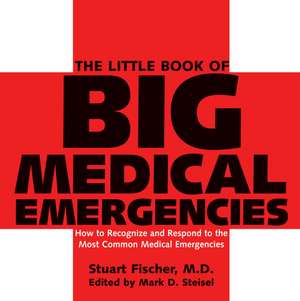The Little Book of Big Medical Emergencies: How to Recognize and Respond to the Most Common Medical Emergencies
Autor Stuart Fischer Editat de Mark D. Steiselen Limba Engleză Paperback – 31 mai 2007
· How to save someone who is fainting, choking, or drowning
· How to tell if someone is having a stroke, heart attack, or epileptic seizure
· How to identify a life-threatening allergic reaction, kidney infection, or pneumonia
· How to perform CPR, make tourniquets, create an emergency kit for your home and car, and much more
Time is of the essence in an emergency; a delay or incorrect decision can be fatal. Simple and easy-to-follow, this little book is the guide to medical emergencies that goes everywhere you do.
Preț: 71.93 lei
Nou
Puncte Express: 108
Preț estimativ în valută:
13.77€ • 14.32$ • 11.36£
13.77€ • 14.32$ • 11.36£
Carte indisponibilă temporar
Doresc să fiu notificat când acest titlu va fi disponibil:
Se trimite...
Preluare comenzi: 021 569.72.76
Specificații
ISBN-13: 9781578262472
ISBN-10: 157826247X
Pagini: 234
Ilustrații: 10
Dimensiuni: 155 x 152 x 13 mm
Greutate: 0.23 kg
Editura: Hatherleigh Press
ISBN-10: 157826247X
Pagini: 234
Ilustrații: 10
Dimensiuni: 155 x 152 x 13 mm
Greutate: 0.23 kg
Editura: Hatherleigh Press
Notă biografică
Stuart Fischer, M.D., a graduate of Yale University, served as an emergency care attending physician at Cabrini Medical Center and the associate medical director of the Atkins Center. He is now in private practice in New York City.
Recenzii
What real people are saying:
“…invaluable information…can make the difference between living and dying…”
“A life-saving guide…of vital use in every home…”
“…belongs in every household…”
“…invaluable information…can make the difference between living and dying…”
“A life-saving guide…of vital use in every home…”
“…belongs in every household…”
Cuprins
Introduction
Basic Principles of Emergency Care
How Emergency Systems Work
When You Call 911
Hospital Admission and Ability to Pay
The Medical Emergencies
Abdominal Pain
Appendicitis
Back Injuries
Bites
Blood Clots (Phlebitis)
Breathing Disorders
Burns
Choking
Cold Exposure (Hypothermia)
Cuts and Bruises
Diabetic Emergencies
Diarrhea
Drowning
Ear Emergencies
Electrical Injuries
Eye Emergencies
Fainting and Collapse (Syncope)
Fractures
Gunshot and Stab Wound
Headaches
Head Injuries
Heart Attacks
Heart Rhythm Emergencies
Heat Emergencies (Hyperthermia)
High Blood Pressure
Kidney Stones
Marine Life Injuries
Neck Injuries
Nosebleeds
Panic Attacks
Pediatric Emergencies
Pneumonia
Poisoning and Drug Overdose
Seizures
Skin Emergencies and Allergic Reactions
Strokes
Urinary Tract Disorders
Women’s Emergencies
Procedures
How to Take a Pulse
How to Give CPR
How to Dislodge an Obstruction from the Throat
How to Stop Bleeding Wounds
How to Make Splints
How to Make Slings
Measuring Vital Signs
Emergency Supply Kits
Tips for foreign Travel
Resources
Index
Basic Principles of Emergency Care
How Emergency Systems Work
When You Call 911
Hospital Admission and Ability to Pay
The Medical Emergencies
Abdominal Pain
Appendicitis
Back Injuries
Bites
Blood Clots (Phlebitis)
Breathing Disorders
Burns
Choking
Cold Exposure (Hypothermia)
Cuts and Bruises
Diabetic Emergencies
Diarrhea
Drowning
Ear Emergencies
Electrical Injuries
Eye Emergencies
Fainting and Collapse (Syncope)
Fractures
Gunshot and Stab Wound
Headaches
Head Injuries
Heart Attacks
Heart Rhythm Emergencies
Heat Emergencies (Hyperthermia)
High Blood Pressure
Kidney Stones
Marine Life Injuries
Neck Injuries
Nosebleeds
Panic Attacks
Pediatric Emergencies
Pneumonia
Poisoning and Drug Overdose
Seizures
Skin Emergencies and Allergic Reactions
Strokes
Urinary Tract Disorders
Women’s Emergencies
Procedures
How to Take a Pulse
How to Give CPR
How to Dislodge an Obstruction from the Throat
How to Stop Bleeding Wounds
How to Make Splints
How to Make Slings
Measuring Vital Signs
Emergency Supply Kits
Tips for foreign Travel
Resources
Index
